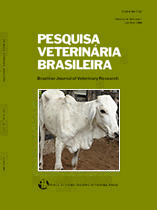 |
|
|
|
Year 2015 - Volume 35, Number 1
|

|
Research of Klebsiella pneumoniae in dairy herds, 35(1):9-12
|
ABSTRACT.- Langoni H., Guiduce M.V.S., Nóbrega D.B., Silva R.C., Richini-Pereira V.B., Salina A. & Guimarães F.F. 2015. Research of Klebsiella pneumoniae in dairy herds. Pesquisa Veterinária Brasileira 35(1):9-12. Departamento de Higiene Veterinária e Saúde Pública, Faculdade de Medicina Veterinária e Zootecnia, Universidade Estadual Paulista Júlio de Mesquita Filho, Campus de Botucatu, Distrito de Rubião Júnior s/n, Botucatu, SP 18618-970, Brazil. E-mail: hlangoni@fmvz.unesp.br
Klebsiella pneumoniae is a common environmental agent of clinical and subclinical mastitis affecting dairy herds, and may be present in the final product decreasing its quality. Mastitis caused by K. pneumoniae is even more severe due to its poor response to antibiotic therapy, rapid evolution to toxic shock and death of the animal. This paper aimed to study the prevalence of this pathogen among dairy herds in ten farms located in different municipalities of São Paulo State based on size and use of milking technology. All mammary glands of all lactating cows were screened using the California Mastitis Test (CMT) and a strip cup. A single aseptic milk sample (20mL) was collected from all CMT-positive quarters and bulk tanks, whereas swab samples were collected from feces, hind limbs of the animals, bedding and milking parlor. Identification of K. pneumoniae was performed using conventional microbiology culture, biochemical assay and Polimerase Chain Reaction. The primers were designed and tested at the Laboratory of Molecular Biology applied to Zoonoses (FMVZ, Unesp-Botucatu) targeting the 16S rRNA gene. This study included 1067 animals. Six cases of intramammary infection by K. pneumoniae were detected in six different cows in two farms. Moreover, K. pneumoniae was isolated in 77 swabs (34 from bedding in 9 farms, 7 from waiting rooms in 5 farms, 6 from milking parlors in 4 farms, 11 from rectums in six farms, and 19 from hindlimbs in 7 farms. Molecular analysis confirmed the agent was K. pneumoniae. At least one strain of the agent was identified in a certain site in all farms, showing the need of maintaining the hygiene in dairy farms. |
| |
|
|
| |
|
 |